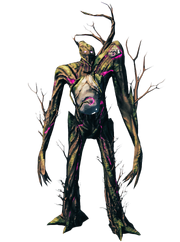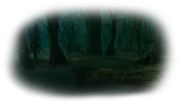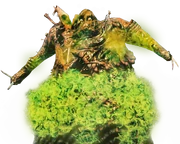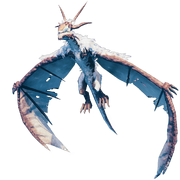This page sets out a new player's progression, as determined by bosses killed and resources available. Check the How to play guide if you are confused as how to play.
Tip: Don't be in a rush to beat the game. Take your time and enjoy the adventure. I have and have known others to take 40 or 50 hours between bosses, fighting and exploring biomes before moving to the next. Enjoy the ride!
Meadows[]

Meadows, the first biome.
You start out with just your Rag Tunic in the middle of the Sacrificial Stones. Your new friend Hugin will be there to guide you every step of the way. You should take his advice.
- Running the coastline to get an outline of the land is helpful before gathering and developing a base. If you die the level loss is very minimal as you haven't developed at all. This will give you a better idea of where you will want to build your first camp. You can gather berries and mushrooms to eat while running.
- Get Wood by picking up branches or punching small trees.
- Get Stone by picking small rocks off the ground.
- Craft a Stone axe from wood and stone. Use it to defend against Greylings and Boars, and to chop down trees to get wood faster. Falling trees are more dangerous at this stage than anything else in the meadows. Be wary when near the border of other biomes.
- As you explore, you can use the in-game map tools to mark points of interest and put a label for when you want to return. Also, in the course of exploring the Meadows, if you encounter a two-star boar (an extremely rare spawn), it may be a more beneficial long-term investment to trap it and keep it alive for taming and breeding (once you've progressed further).
Explore more until you are content and you've decided on where you want your first home. Don't get too attached to your first home. You are likely to move several times.
- It does not have to be particularly defensible at this time, but close to a coast is preferable for access to flint.
- As you explore, pick Raspberries and Mushrooms. You can eat them regularly to get a small bonus to maximum HP/stamina and healing over time. They will respawn after sufficient time, so long as the berry bushes are not destroyed.
- Craft a Hammer. Use it to craft a Workbench. Before you can use your workbench to craft or repair items, it needs to be "covered," meaning at a minimum there are some walls around it and a roof overhead. The simplest way to do this is to build two 2x2 walls behind the workbench, one on either side (total: 4 walls), and two roof pieces overhead. The workbench does not need to be covered in order to place building pieces.
- Repairing items and buildings costs no resources. Item durability being reduced to zero does not have any negative consequences other than being unable to use the item (including equip the item) until the durability is restored. To repair, click the hammer button on the workbench interface, and it will repair any eligible item in your inventory, one per click of the button.
- Build a basic shelter. Your workbench and Bed will need to be covered to work fully.
- A wood-fueled lit Campfire is needed near the bed to sleep. Note that campfires cannot be placed on wood floors. The fire needs to be outside or if inside needs space above it for the smoke to escape, otherwise smoke will damage you over time. Fires will be smothered by rain or insufficient smoke ventilation. To ensure that your fire stays lit even in rainy weather, build a roof over it.
- Build Cooking stations over your campfire, roast the meat from the deer and boars for more health and health regeneration. Notice that food is split into three types: stamina-focused (yellow fork), balanced (silver fork), and health-focused (red fork). Balancing the bonuses from food to fit the task at hand is will maximize your chances of survival.
You can sleep at night. This may be helpful for the first few nights, as more monsters spawn at night.

Eikthyr, the first boss.
Prepare for the boss fight:
- Pick up Flint on the beach, this is best used to make a flint spear, knife, or axe, along with workbench upgrades.
- Hunt Boars for meat and Leather scraps.
- If seeking to fight the first boss using ranged weapons, craft a Crude Bow and wood arrows or Fire arrows. Arrows require feathers, which you get from shooting birds, and very occasionally when cutting down trees.
- For a melee combat, you can craft a shield to go with your main hand weapon.
- Craft a Chopping block to upgrade your weapons to level 2, then a Tanning rack to upgrade your equipment further.
- With the bow, hunt deer. Hunting with a spear is also an option, but more difficult because of the shorter throw range. At beginning skill levels, it is extremely difficult to try killing a deer using melee attacks.
- With the deer hides, craft leather armor.
- Find some abandoned houses with Beehives in them. Destroy these with the bow or thrown spear. If you hit them in melee range, the bees will poison you. You can also build a workbench and destroy the walls the beehive is attached to. Beehives will drop a Queen bee. This lets you build your own beehives, which generate honey over time, a decent stamina food for the boss fight.
Then it's time for the first boss fight. See Eikthyr for tactics. Beginning the boss fight at the start of a new day will minimize the chances of the fight carrying over to the nighttime, where the fight will be significantly more difficult.
Black Forest[]

Black Forest, the second biome.
After collecting antler pieces from Eikthyr, you can now craft the antler pickaxe to mine ore and stone. First, place the Eikthyr trophy on the Sacrificial Stone (have it in your inventory and press the interact key). Follow Hugin's instructions to receive the Forsaken Power of Eikthyr which reduces your running and jumping stamina use by 60%.
Raw ore is no good by itself. Further preparations are needed to begin smelting and enter the Bronze Age:
- Head to the Black Forest and look for Burial Chambers.
- Your objective is to find Surtling cores which are used in the construction of the Smelter and the Charcoal kiln. You may need to search multiple chambers to collect enough of them - each smelter and kiln requires five cores.
- When exploring the dark underground chambers, a Torch may serve as a light source, held in the off-hand while you hold another one-handed weapon. To do this, equip the torch first, then equip the weapon, and your character will now hold both a torch and weapon. The torch itself has low durability and should not be used as a weapon.
- Skeletons resist pierce damage, so the preferred weapon when exploring for surtling cores is a club or axe.
Note: In the Black Forest biome you will find Thistle. These are used in large quantities for crafting mid-tier food. Collect them and store them for later.

The Elder, the second boss.
Once you have set up the Smelter and the Charcoal kiln you should aim to process as much copper and tin as you can find. Copper can be found in large deposits in the Black Forest. Tin can be found near water in the Black Forest, similar to flint. These are combined at a Forge, using 1 tin and 2 copper to make a single ingot of Bronze. Ore and Metal Bars cannot be teleported.
- Prioritize the Bronze axe, which allows you to collect Fine wood from Birch and Oak trees back in the Meadows.
- Fine wood unlocks more crafting recipes, including better furniture, the Finewood bow, and portals.
- A thoughtfully maintained portal network will save you a lot of time. However, portals require precious surtling cores which you can't farm at this stage of the game.
- The Karve boat and Cart can help with moving the metals, so consider making this a priority if the Black Forest is a long distance from your base.
- Core wood from Pines found in the Black Forest allow you to build taller, bigger buildings than before.
- Weapons and armor crafted at the Forge also can only be repaired at the Forge. Watch the durability of your items and repair before leaving your base.
- The armor options in the Bronze Age are Troll armor and Bronze armor. Troll armor has lower defense, but does not reduce movement speed, and can also be repaired at the workbench. Bronze armor has high defense but makes you move slower.
- Building a cauldron lets you turn raw food and ingredients into much better food. For the rest of the game, you will probably be eating processed cauldron food rather than raw food.
- Mead bases crafted at the cauldron can be fermented using the Fermenter. Meads are basically potions in Valheim, providing buffs and regeneration.
- Bronzehead arrows are not worth making. You will often find that after leveling your bow skills and your finewood bow, you one shot most smaller Black Forest Mobs with a backstab from a wood, flint, or fire arrow. These three will be more than sufficient and very cost effective until late game arrows.
- At some point you should have come across carrot seeds. Plant these with a Cultivator for Carrots.
- Somewhere in the Black Forest you can find Haldor, Valheim's merchant. He does not move once found, and is the only place to spend Coins. The Megingjord that he sells is the only item in the game which increases carrying weight (by 50%!).
Once you feel comfortable with your setup and have taken the time to upgrade some of your tools and potentially the armor, you will be ready to fight the Elder. See The Elder for tactics.
Swamp[]

Swamp, the third biome.
You will now have the swamp key after defeating The Elder, which grants you access to sunken crypts in the swamp biome. Sunken crypts are the first major source of scrap iron. Prepare to enter the Iron Age.
IMPORTANT: It is always raining in the swamps and the Wet Effect will always be applied as a result. Stamina management is a top priority at all times. Don't be afraid to walk unless you need to run. You do NOT want to be in there without the Rested Effect. Take the time to upgrade your home to maximize your rest timer. 18-ish minutes of rest at this point shouldn't be hard to achieve.
- Some swamp biomes will contain very few sunken crypts, while others will contain many. Some crypts will contain a lot of muddy scrap piles, while others will not. Your mileage may vary so be aware that you will most likely have to move from swamp to swamp to collect enough iron if you are playing with a team.

Bonemass, the third boss.
The Swamp introduces new enemies that do enough damage to kill well armored players. When moving through the swamp, it is important to have good quality food to give you enough stamina and health to deal with the enemies. You will also want to invest time into making Poison Resistance Meads at this stage to help with blobs, oozers, and leeches. Once you have a Root Mask, the Poison Resistance Mead will not be needed.
- Scrap iron also cannot be teleported. Iron itself is necessary in fairly large quantities for Iron Age weapons and armor.
- Ancient Trees yield Ancient bark, which is used for certain weapons, armor, and the Longship.
- The one-handed Iron Mace is the best Iron Age weapon to fight Bonemass and its minions, as it is resistant or very resistant to all other damage types likely available at this time. The Iron Mace is highly effective against nearly all enemies in the swamp, including blobs, oozers, and draugr.
- The uncommonly-spawning Abominations drop Roots to craft the Root Set, which boosts bow damage. Abominations also drop Guck, which is otherwise annoying to chop off of Gucksacks.
- Poison damage is also reduced by armor, which is not intuitive.
- Wraiths only spawn at night in the swamp, and may be farmed for their Chains, a necessary material for higher-tier weapons, armor, and crafting station upgrades.
- Surtlings spawn around Fire geysers in the swamps, and you can now more readily farm Surtling cores to build more smelters and portals.
- Iron is also used to build a Stonecutter, which allows you to now build stone buildings and castles. Wood iron poles allow you to build even bigger and taller than Core wood.
- The swamp itself is generally a poor location to build a base, between the constant rain, aggressive enemies, low elevation, and lack of abundant wood or stone to construct buildings.
- Turnip Seeds grow occasionally in the swamps. Collect these to grow Turnips. Thistles can be found in small quantities in the swamp, but the Black Forest is a much better source.
Once you feel comfortable with your setup and have taken the time to upgrade some of your tools and potentially your armor, you will be ready to fight Bonemass. See Bonemass for tactics.
Mountains[]

Mountains, the fourth biome.
You will now have the wishbone after defeating Bonemass, which allows you to find silver veins hidden in the mountain biomes. The key environmental hazard in the Mountain is the freezing status effect that will kill you slowly (1 dps) unless you quaff a Frost Resistance mead or have equipped a wolf fur cape or wolf chest. The first objective after defeating Bonemass is to locate the nearest large, high-elevation Mountain biome to begin finding and mining silver.

Moder, the fourth boss.
The Mountain introduces new enemies that will do even more damage (wolves and Stone Golems), more than enough to kill otherwise well armored players. Drakes will be very difficult to kill without a bow and arrows. When moving through the Mountain, it is important to have good quality food to give you enough stamina and health to deal with these enemies. Climbing steep mountain sides is a big stamina drain, and running out of stamina on the way up a mountainside is a surefire way to fall to your death. Pick your fight location accordingly when you can.
- If you don't want to carry frost resistance meads, you can collect silver and wolf pelts to make a wolf fur cape or chest.
- With silver, you will now be able to craft the Draugr fang. Most of the other weapons in the Silver Age are only fairly marginal upgrades over the Iron Age weapons.
- Silver can only be mined with an Iron Pickaxe or better. Silver ore cannot be teleported, like other ores and metals.
- Nighttime in the Mountain is especially dangerous for the unprepared viking. Enemies will spawn at fairly high rates, including starred Wolves who can deal extreme damage, even through a shield block.
- In large, high-elevation mountains, Frost Caves can be found. These are not mandatory for progression, but the enemies inside will drop items necessary to craft the Fenris Set, which is the only armor which increases movement speed and has a set bonus increasing proficiency with Fists.
- Chests in the Mountains will occasionally contain Onion seeds. Grow Onion seeds to ensure that you do not run out of Onions, which are used in endgame cooking recipes. Crops don't grow in the Mountains.
- Upgrading your Cauldron with silver (the second cauldron upgrade, the Butcher's table) is necessary before unlocking recipes to cook Mountain-tier foods.
- Crystal drops from stone golems or from inside frost caves are used to craft Crystal wall 1x1, which can be used as transparent "window" glass-like panes.
Once you feel comfortable with your setup and have taken the time to upgrade some of your tools and armor, you will be ready to fight Moder. See Moder for tactics.
Plains[]
After killing Moder you will receive a few Dragon Tears. This will give you access to the Artisan Table, which is necessary to workstations to produce endgame items, the raw materials for which can be found in the plains. The plains have some of the most dangerous mobs yet. The Deathsquito has claimed countless lives.
The plains can be very peaceful or very dangerous. At night, the plains are filled with roving bands of Fulings.
- One artisan table can be used to build as many Blast furnace, Windmill, and Stone oven as you want. It can be disassembled and reassembled anywhere without material penalties.
- Black metal is the plains-tier metal. Fulings drop Black Metal Scraps. Alone, they do not pose much of a threat.
- Fuling Villages are the main source of Flax and Barley, which only can be replanted and regrown in the plains. Flax is used for equipment, while Barley is used for food. While an individual fuling does not pose much of a threat, the large groups of fulings (including Berserkers and Fuling shamans) in villages can quickly kill you.
- Five Fuling totems are required to summon Yagluth. They can be occasionally found in fuling villages, and it may require a substantial amount of exploration to find five.
- Lox are found in small herds in the plains. They drop meat and pelts, but deal heavy damage. They can also be tamed and ridden. Lox resist most types of damage, and pierce (spears or bows) is the most effective way to deal with them.
- Tar pits are unique formations found only in the plains. Beware of the Growths, which can quickly kill an unprepared adventurer. Collecting Tarunlocks cosmetic and furniture upgrades and the Black metal chest, the largest-capacity chest currently in-game.
- Deathsquitos are a constant nuisance but can be easily dealt with with proper timing and familiarity with their attack patterns.
- Because Flax and Barley can only be grown in the plains, it may be necessary to build a defensible base in the plains to protect your crops.
When adequately prepared, you can now face Yagluth.
Mistlands[]
The Mistlands terrain is erratic and difficult to fight on, and the dense mists make it difficult to see aggressors, so being vigilant is key. Seekers are the main hostile mob you'll encounter here, though you'll also rarely encounter Seeker soldiers, as well as the airborne Gjall and the Ticks that they spawn.
The Torn spirits that you received from Yagluth can be used to construct a Wisp fountain, which attracts wisps in any biome (you don't need to build them in the Mistlands), during the night or in rainy weather. The wisps can be used to craft a few items, most notably the Wisplight, a utility slot item that follows you and disperses mist around itself, and Wisp torches to dispel the mist in larger areas or even during exploration. In the event of your death in the Mistlands, the wisplight will be dropped, and you may have to craft a new one to do a corpse run.
Once you arrive, your first priorities should be gathering new materials and scouting the environment.
Materials[]
- The thin trees in the area require a Blackmetal axe to cut down, and yield Yggdrasil wood which is used in a number of new recipes.
- Hares are non-hostile creatures that drop Hare meat and Scale hide.
- The new resources in the Mistlands require a Black metal pickaxe to mine.
- Seekers drop Carapace which will be used in the new tier of armour and ammunition.
- Seeker soldiers also drop Mandible, used in some new weapons.
- Gjall are tough to kill, but drop Bilebag when slain, which are used in a couple of new crafts.
- The ticks drop Blood clot which are used in some mead and food recipes.
- Jotun puffs and Magecap can be found scattered around, both of which are used in new food recipes. Magecaps tend to spawn in the peaks, whereas Jotun puffs spawn mostly in lower areas. Both can be farmed and regrown only in the Mistlands, which means that you may want to consider building a base in the Mistlands as well.
- Black marble which enables the construction of Dvergr-style structures and new work stations.
Scouting[]
Keep an eye out for the following structures:
- Large glowing Ancient Roots, from which Sap can be harvested.
- Ancient armour pieces and swords - these can be mined for Scrap iron, providing an alternative source from Swamp crypts.
- Dvergr towers and mining camps - the Dvergr are a passive race normally, only attacking you if you attack them first, or if you anger them by stealing from their homes.
- Sometimes, Dvergr structures are inhabited by groups of Seekers instead - if they are towers, check the basement for a possible dungeon entrance (see below).
- Giant Remains, ribcages and skulls - the skulls are particularly important, because they contain Soft tissue used later for Eitr refinement.
Infested Mines[]
The Infested Mines dotted around the Mistlands are key to accessing new items, as they are your only source of the Black cores needed to make the new workstations.
There are two types of entrances to infested mines - one which is set into a hillside with a long black marble stairwell, and the other is in the basement of overrun Dvergr towers. Both are guarded by groups of seekers.
The mines themselves are labyrinthine dungeons full of Seekers, Seeker soldiers, Seeker broods and Ticks. The broods are useful for their Royal jelly drops, which are a key food ingredient. The black cores are usually mounted on pedestals in hidden rooms, indicated by blue runic markings on the walls.
Another thing to look out for are pedestals containing Sealbreaker fragments - you will need 9 of these to eventually unlock the lair of The Queen, so make sure to keep hold of them.
Finally, you may run into a Vegvisir indicating the location of The Queen.
Once you have at least 5 black cores, you can construct a Black forge, where you can make most of the new Mistlands items.
Sap[]
The next step in Mistlands progression is Sap. This is obtained by attaching a Sap extractor to the glowing tree roots scattered across the Mistlands and waiting for them to fill up. Sap extractors require a workbench nearby to place, and need three components: Yggdrasil wood, Black metal and a Dvergr extractor. Black metal is not available in the Mistlands, so it must be shipped in from other bases.
The Dvergr extractor can only be obtained from Dvergr component crates, which appear in inhabited Dvergr towers and mining camps. The catch is that breaking the crate angers the nearby Dvergr, so you may want to take advantage of nearby enemies attacking the camp to clear out the weakened occupants and claim the extractor. Alternatively, the Dvergr will not be angered if an enemy breaks the crate for you. Like all metals, the Dvergr extractor cannot be teleported.
Eitr[]
The sap can be used to construct the Eitr refinery, a structure that converts sap and soft tissue into Refined eitr, the core crafting component of Mistlands items. The refinery is actually dangerous while in operation, frequently firing off sparks of elemental damage in all directions, so you should keep it away from other structures or encase it in black marble or an iron cage when using it.
Armed with refined eitr, you can finally construct a Galdr table, the last remaining crafting station, which is used to make Magic items, as well as the Sealbreaker - the key to reaching The Queen.
Ashlands[]
The Ashlands are home to the game's greatest challenges thus far.
A fiery realm at the south edge of the world, the terrain changes the more inland one travels, with central parts taken up by lava. The undead army of Charred make up most of the population.
Deep North[]
(Unfinished) Snow-capped hills with frozen rivers in the far north of Valheim.
What to do next?[]
Valheim is still in development. The next biome being developed is the Ashlands. Because of the way that the Valheim world generates, exploring these undeveloped biomes has no benefit to the player. In fact, areas generated before the biomes are further developed will not be retroactively generated after development.
At any point, you may decide that you would rather build a cool structure or tend a large herd of boars. There is no "right" or "wrong" way to play this sandbox game.
